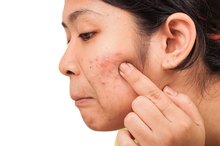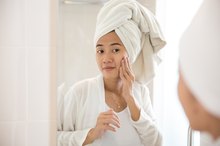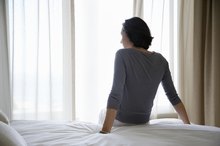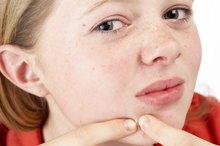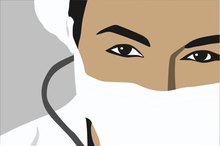What does fact checked mean?
At Healthfully, we strive to deliver objective content that is accurate and up-to-date. Our team periodically reviews articles in order to ensure content quality. The sources cited below consist of evidence from peer-reviewed journals, prominent medical organizations, academic associations, and government data.
The information contained on this site is for informational purposes only, and should not be used as a substitute for the advice of a professional health care provider. Please check with the appropriate physician regarding health questions and concerns. Although we strive to deliver accurate and up-to-date information, no guarantee to that effect is made.
Vaginal Acne
Vaginal acne is a skin problem that is typically caused by a change in your hair follicles and sebaceous glands. Although a fairly common condition among women, vaginal acne can be irritating, embarrassing and uncomfortable. According to Healthy-Skin-Guide, genital acne is not dangerous and may be treated with natural remedies 1.
Causes
Acne may appear on any part of your body including your vagina. There are many factors that play a role in the development of these pimples such as:
- hormonal changes
- certain detergents
- stress
- diet
- overproduction of body oils
- medications
- some health conditions
In addition, teenagers experiencing puberty may develop vaginal acne. Some acne may also be caused by bacteria in your pores leading to infection.
Symptoms
Remedies for Vaginal Pimples
Learn More
Symptoms of vaginal acne may include red, tender and inflamed bumps on or around the vaginal area. Pain and itching may accompany the bumps on the affected area.
Appearance
The appearance of vaginal acne may be different for each individual. The acne bumps may appear red and inflamed along your panty line and feature a whitehead or blackhead rising above the bump. A buildup of skin cells and oils causes the pore at the site of the bump to clog, giving it the appearance of a blackhead. Additionally, dry skin may appear in some areas. Bumps that develop deep under the skin are known as nodules and may be very painful.
- The appearance of vaginal acne may be different for each individual.
- The acne bumps may appear red and inflamed along your panty line and feature a whitehead or blackhead rising above the bump.
Treatment
Menopause & Bumps on the Labia
Learn More
Treatment for vaginal acne may consist of prescription acne medications such as benzoyl peroxide. The website Mayo Clinic states that acne treatments work by fighting bacterial infection, speeding up skin cell renewal and reducing inflammation 2. In addition, it may take up to eight weeks to notice improvement. Natural remedies that may be used to treat vaginal acne may include lavender essence oil used as an antiseptic or azadirachta indica that carries anti-inflammatory and anti-bacterial properties. Consult with your physician before attempting to self-treat any skin conditions.
- Treatment for vaginal acne may consist of prescription acne medications such as benzoyl peroxide.
- Natural remedies that may be used to treat vaginal acne may include lavender essence oil used as an antiseptic or azadirachta indica that carries anti-inflammatory and anti-bacterial properties.
Warning
Symptoms of certain sexually transmitted diseases my resemble those of vaginal acne. Genital herpes is a common STD acquired through sexual intercourse. Symptoms of genital herpes include bumps, blisters and pimples on or around the vaginal area similar in appearance to those of vaginal acne 1. Additionally, genital warts are contracted through sexual intercourse and have a cauliflower like appearance. If you show symptoms of vaginal acne, consult with your physician for diagnosis and treatment.
- Symptoms of certain sexually transmitted diseases my resemble those of vaginal acne.
- Additionally, genital warts are contracted through sexual intercourse and have a cauliflower like appearance.
Related Articles
References
- Healthy-Skin-Guide: Genital Pimples
- Mayo Clinic: Acne
- Kraft J, Freiman A. Management of acne. CMAJ. 2011;183(7):E430-5. doi:10.1503/cmaj.090374
- Sutaria AH, Masood S, Schlessinger J. Acne Vulgaris. [Updated 2019 Dec 13]. In: StatPearls [Internet]. Treasure Island (FL): StatPearls Publishing; 2019 Jan-. Available from: https://www.ncbi.nlm.nih.gov/books/NBK459173/
- American Academy of Dermatology. WHAT CAN CLEAR SEVERE ACNE?
- Cleveland Clinic. Rosacea (Adult Acne). Last reviewed October 10, 2019.
- American Academy of Dermatology. IS SPORTS EQUIPMENT CAUSING YOUR ACNE?
- American Academy of Dermatology. I HAVE ACNE! IS IT OKAY TO WEAR MAKEUP?
- Zaenglein AL, Pathy AL, Schlosser BJ, Alikhan A, Baldwin HE, et. al. "Guidelines of Care for the Management of Acne Vulgaris." Journal of the American Academy of Dermatology; 2016. 74(5):945-73.
Writer Bio
Michelle Lawson began her professional writing career in 2010, with her work appearing on various websites. She emphasizes alternative approaches to health-related issues. She is certified as a Sports Nutritionist by the International Fitness Association. Lawson graduated from ATI College of Health with honors, earning her associate degree in medical assisting.


